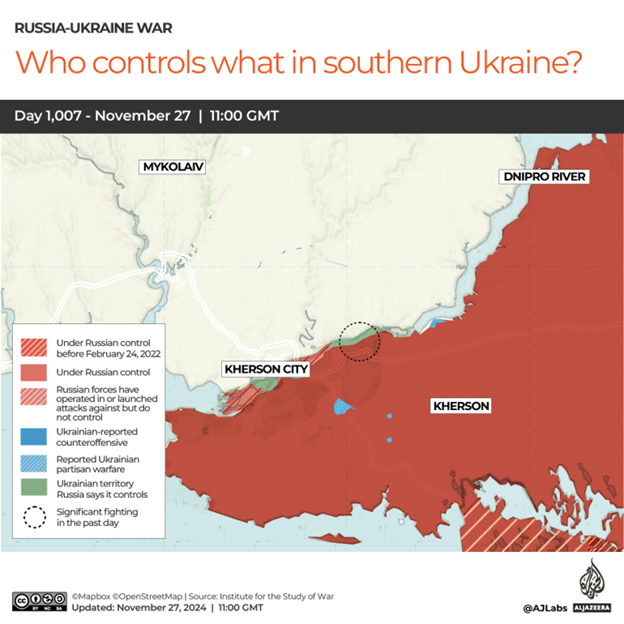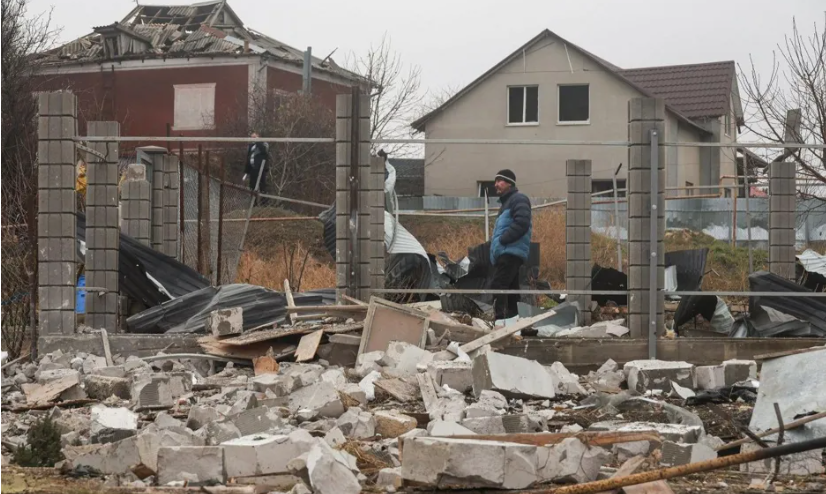(Al Jazeera Media Network) The United States on Tuesday provided the first official confirmation that its long-range Army Tactical Missiles (ATACMS) were in use in Russia, as Europe absorbed the ramifications of Russia’s retaliatory response with an intermediate ballistic missile that could strike “anywhere in Europe”.
As the question of strategic escalation swirled around NATO capitals and Moscow, Russian forces continued a dogged advance through Ukraine’s eastern Donetsk region, seizing more villages.
“Right now, they are able to use ATACMS to defend themselves, you know, in an immediate-need basis,” White House national security spokesperson John Kirby told reporters. “And right now, you know, understandably, that’s taking place in and around Kursk, in the Kursk oblast.”
In a change of communications tactics, the Russian Ministry of Defence, too, acknowledged Ukrainian ATACMS strikes.
Moscow authorities have often fudged Ukrainian missile and drone hits, claiming “falling debris” from a destroyed incoming missile has struck infrastructure and inflamed it.

But on Tuesday Russia’s Defence Ministry acknowledged that ATACMS struck an S-400 air defence radar at Lotarevka on Saturday and the Khalino airfield on Monday. Both objects are about 90 km from Ukrainian front-line positions in Kursk. Geolocated footage confirmed the hits.
The apparent reason for Russian acknowledgement is Russian President Vladimir Putin’s promise to retaliate as appropriate when ATACMS or other long-range weapons are used. Britain and France have licensed Ukraine to fire 200-km-range SCALP/Storm Shadow missiles into Russia.
Russia fired a new type of intermediate-range ballistic missile at the central Ukrainian city of Dnipro last Thursday, in retaliation against the first ATACMS and Storm Shadow strikes earlier in the week.
The missile, dubbed Oreshnik and carrying six warheads, was aimed at a missile and aerospace factory. Ukrainian officials said it caused no serious damage.

In a television address after the Oreshnik strike, Putin threatened those European countries whose weapons were used against Russia: “We consider ourselves entitled to use our weapons against military facilities of those countries that allow their weapons to be used against our facilities.”
“It can hit targets throughout Europe,” Sergei Viktorovich, commander of Russia’s Strategic Missile Forces, said in a staged meeting with Putin on Friday.
In a more menacing tone, Putin suggested a cluster of Oreshnik missiles would have the effect of a nuclear weapon.
“Due to its striking power, especially when used in a massive, group manner, and in combination with other high-precision long-range systems that Russia also has, the results of its use against enemy targets will be comparable in effect and power to strategic weapons.”
“We have a reserve of such products, a reserve of such systems ready for their use,” Putin said.
Vasily Petrovich, first deputy chairman of the Military Industrial Commission, said the Oreshnik had been built “entirely on Russian technologies”, adding that “the issues of import substitution have been resolved” and that Russia’s defence industrial base “allows for the serial production of this type of weaponry.”

Non-Russian observers were not so sure.
Kyrylo Budanov, the head of Ukrainian intelligence, told RBC-Ukraine that Russia did not have mass production capacity.
“The missile is experimental. We knew for sure that two prototypes were supposed to be made by October, maybe a little more. But this is a prototype,” Budanov said.
Oreshnik, which means hazelnut tree, was the codename for the research program that produced the missile, he added. The missile itself was called Kedr, or cedar.
Observers were also unsure that the Kedr represented a new Russian technology.
Pentagon spokesperson Sabrina Singh said it was based on the RS-26 Rubezh intercontinental ballistic missile. Weapons analysts said it had been in development “for some time”.
Kedr warheads were capable of travelling at speeds of 2.5 to 3 kilometres per second on their final approach to their target, said Putin, making them impossible to intercept with existing technologies. But Russia has used ballistic weapons on Ukraine already.
The Kedr used on Thursday was part of a cluster of missiles that included a Kh-47 Khinzal ballistic missile and six Kh-101 cruise missiles.
Ballistic missile warheads are very difficult to intercept because of their terminal speed and because they are unguided in their final stage, making them impossible to jam or disorient using electronic warfare. They can best be intercepted at the launch and ascent stages, but Budanov said the Kedr’s entire flight lasted only 15 minutes from launch to impact, leaving a very small interception window.

Ukraine and Russia traded more conventional aerial attacks during the past week. Ukraine’s general staff said their forces had struck a Russian oil depot in the Kaluga region on Monday. Russia launched a record number of drones and missiles into Ukraine on Tuesday, including four Iskander ballistic missiles and 188 drones.
Russia’s advance in Donetsk was also speeding up, according to an assessment by the Institute for the Study of War, a Washington-based think-tank.
“The frontline in Donetsk Oblast is becoming increasingly fluid as Russian forces recently have been advancing at a significantly quicker rate than they did in the entirety of 2023,” said the ISW.
Russian troops had accelerated their advance in Ukraine and had effectively disrupted Kyiv’s 2025 military campaign, Russian defence minister Andrey Belousov said last week.
Russian forces had reportedly seized a string of villages north of Vuhledar, a town they had lost to last year’s Ukrainian counteroffensive but reconquered in October.
“Russian forces have significantly increased the tempo of their advances in the Pokrovsk, Kurakhove, Vuhledar, and Velyka Novosilka directions since September 1, having gained at least 1,103 square kilometres in these areas,” said the ISW, in contrast with gains of just 387 square kilometres in all of 2023.
The ISW assessed that Russian gains in September averaged 14 square kilometres a day, but 22 sq km a day since November 1.
This is still small compared with the 1,265m sq km Russian troops seized per day in March 2022, but it represented a notable increase relative to the last two years.



